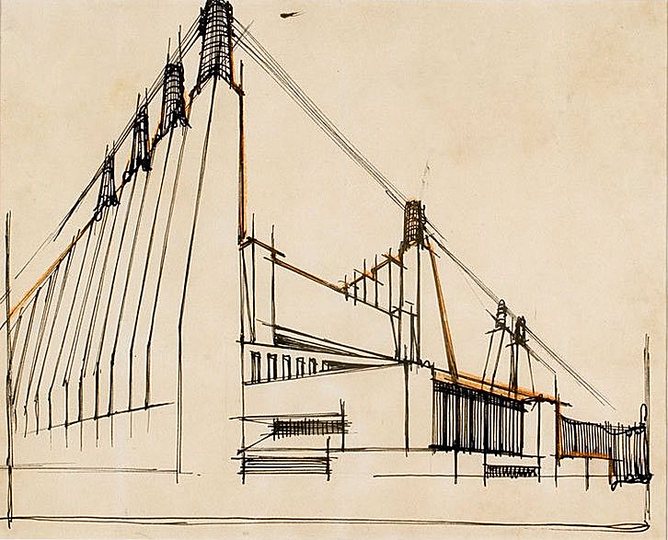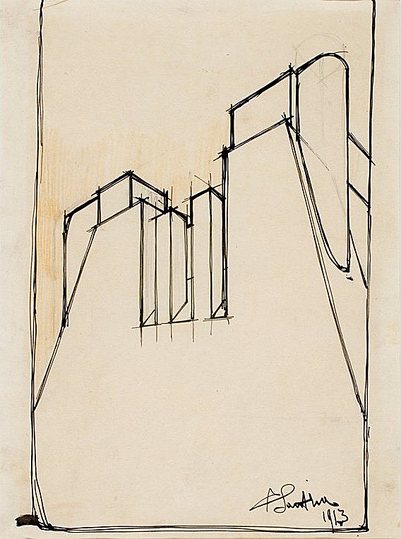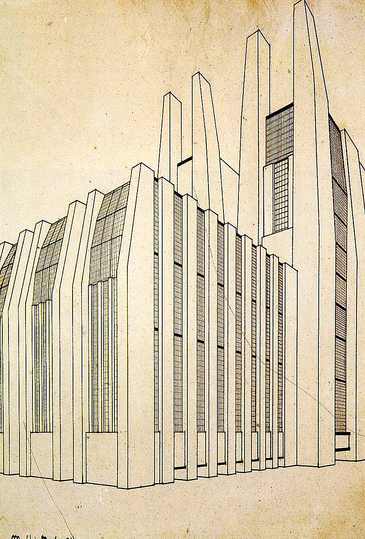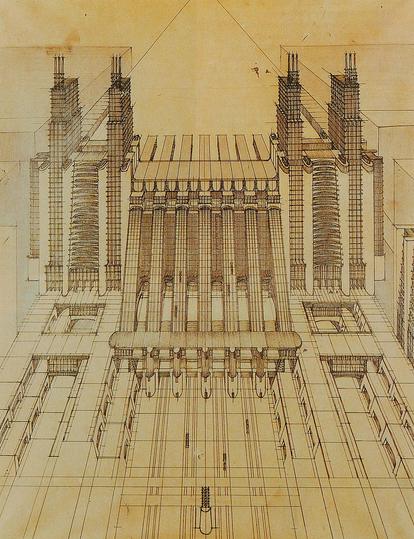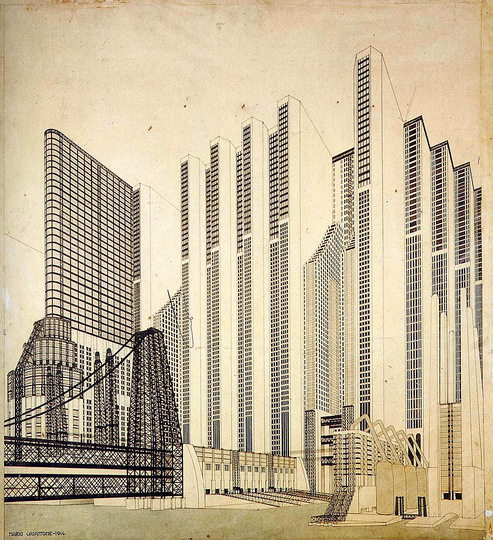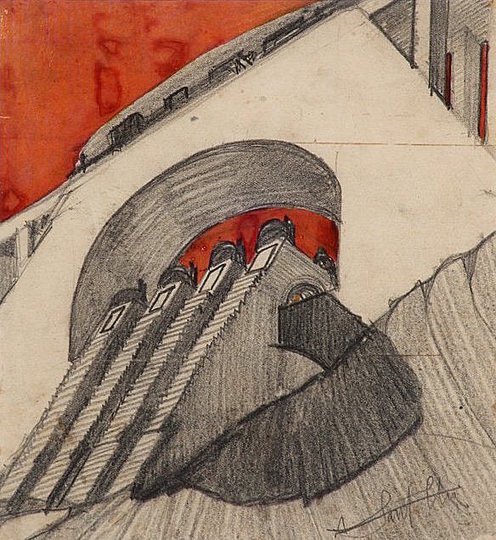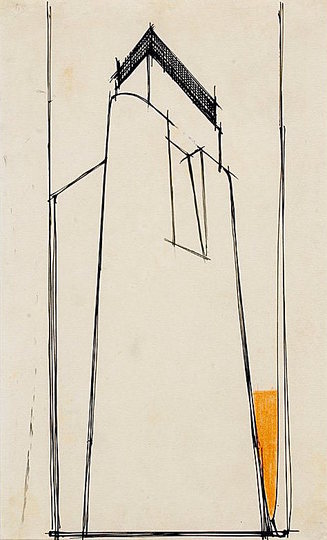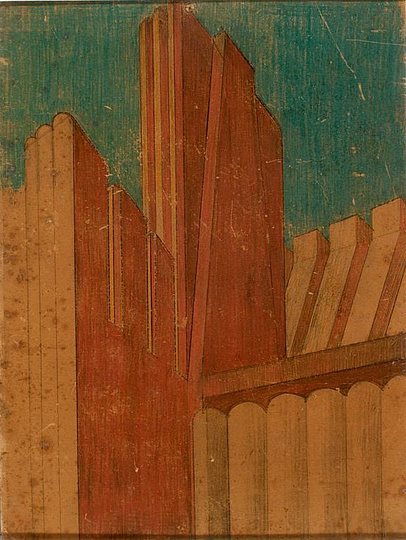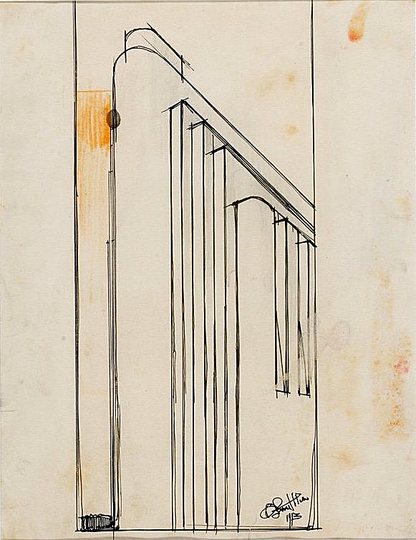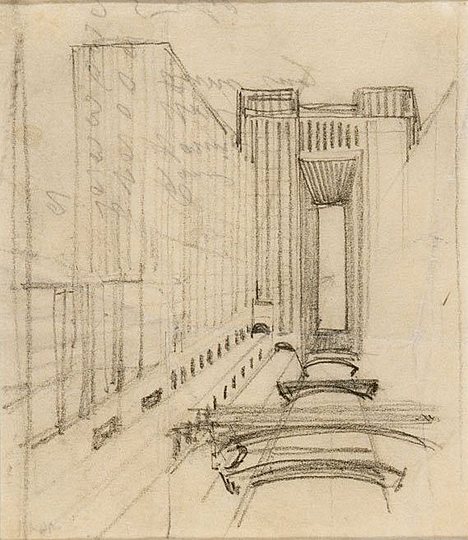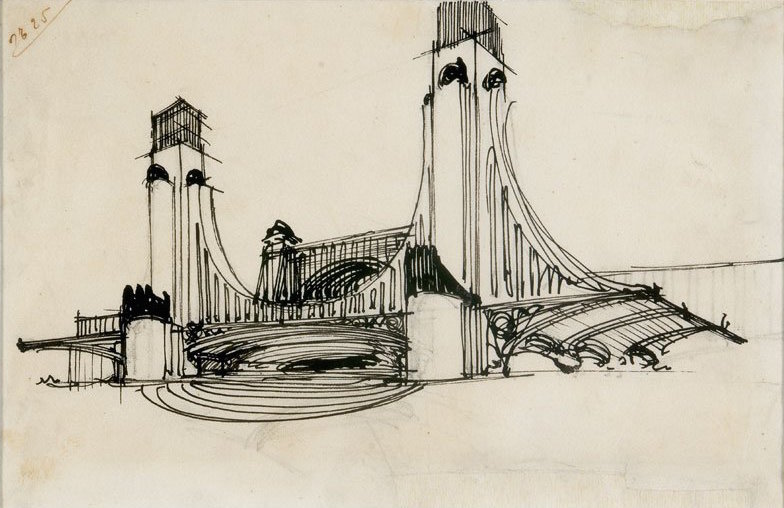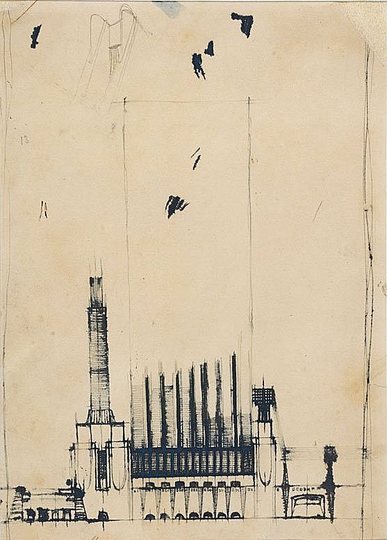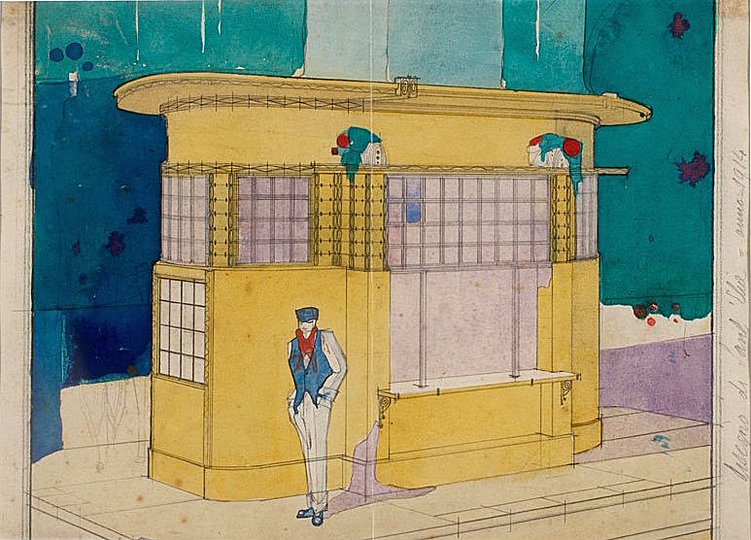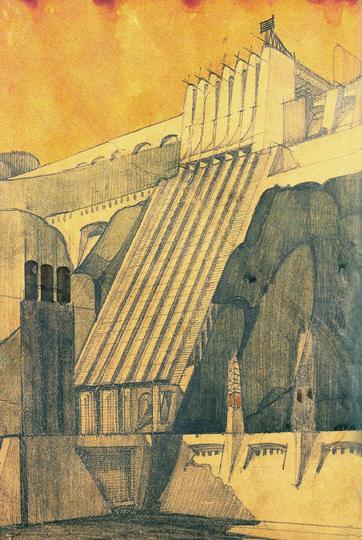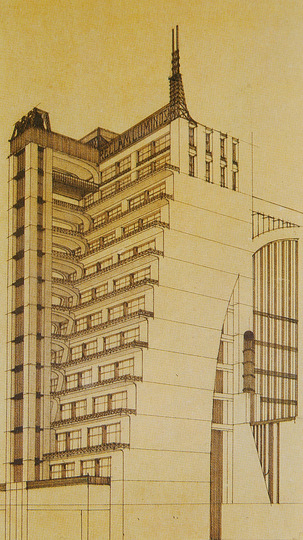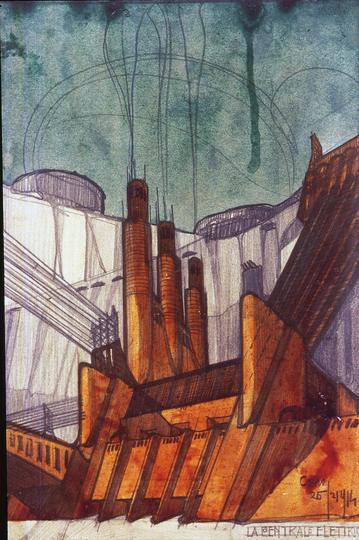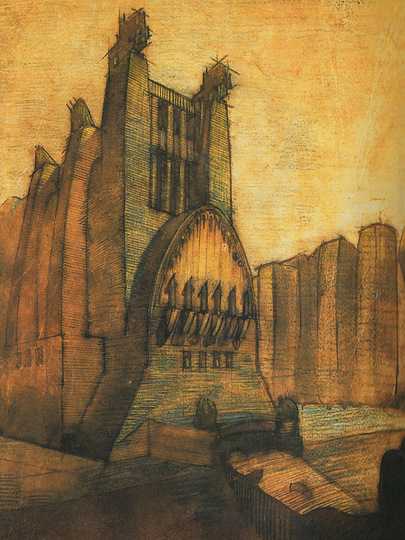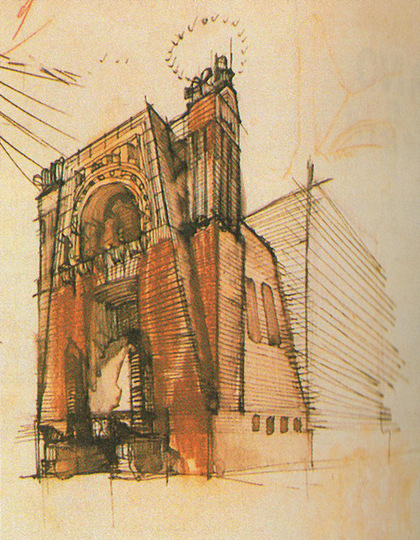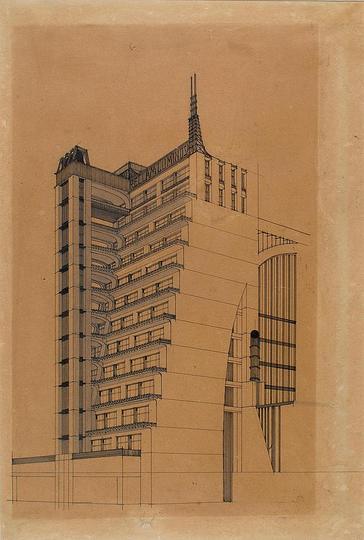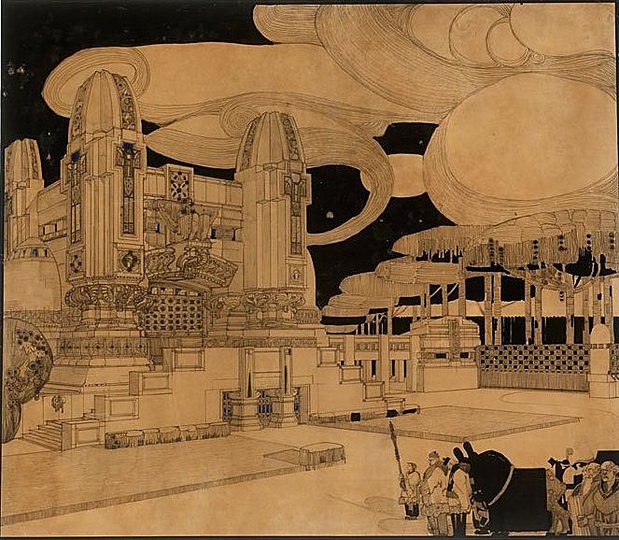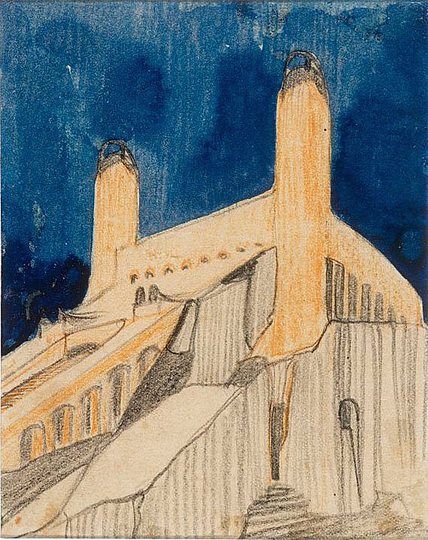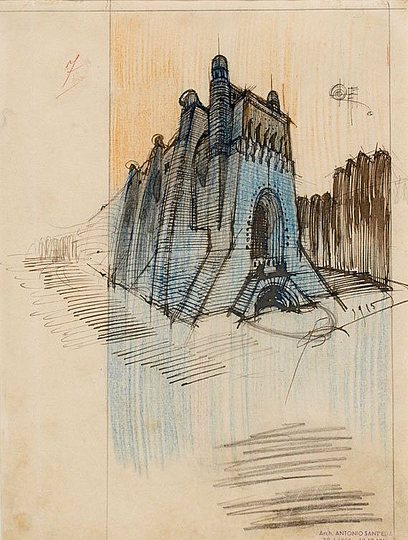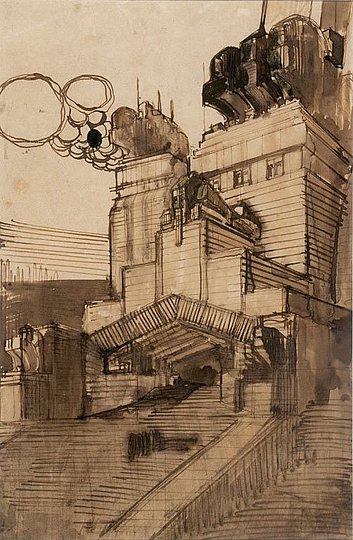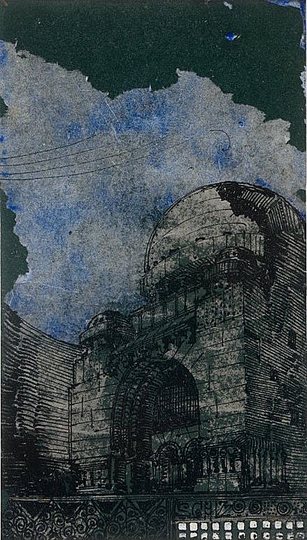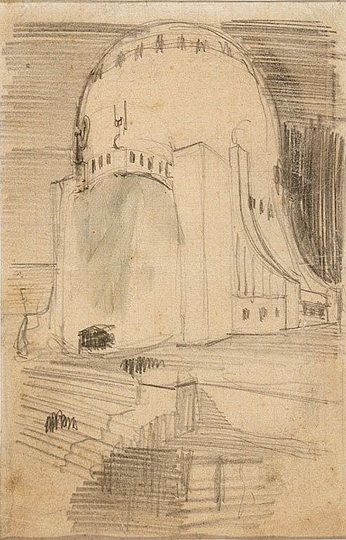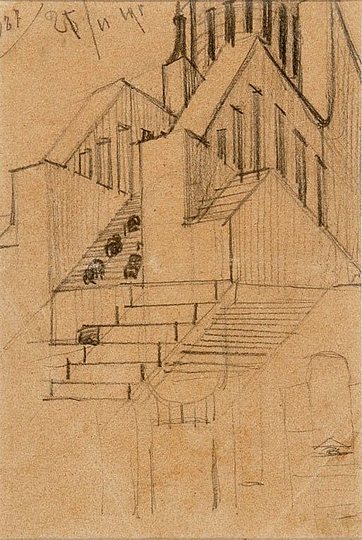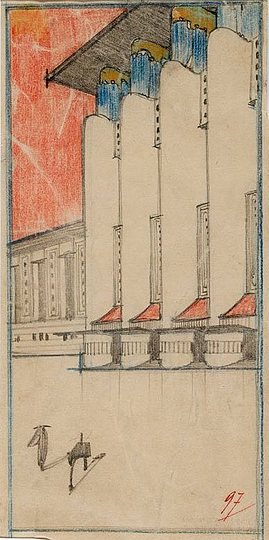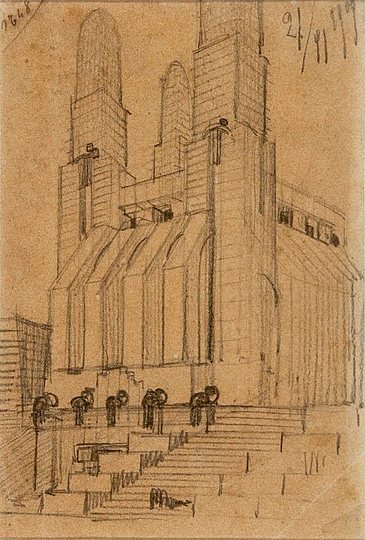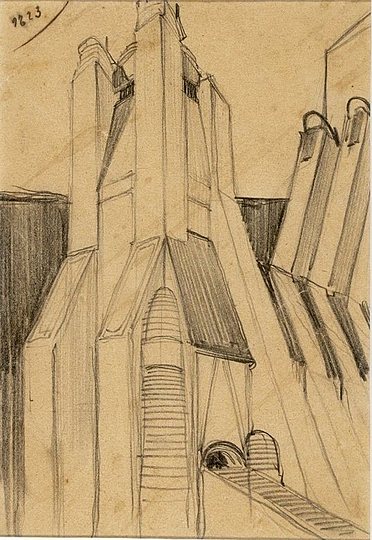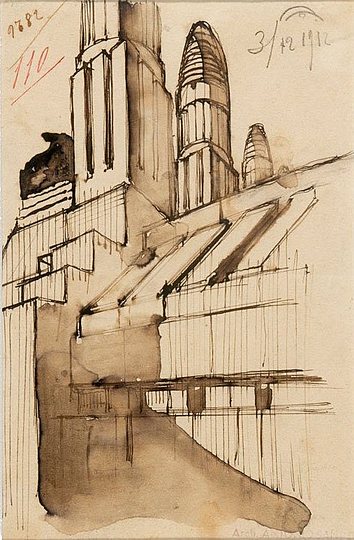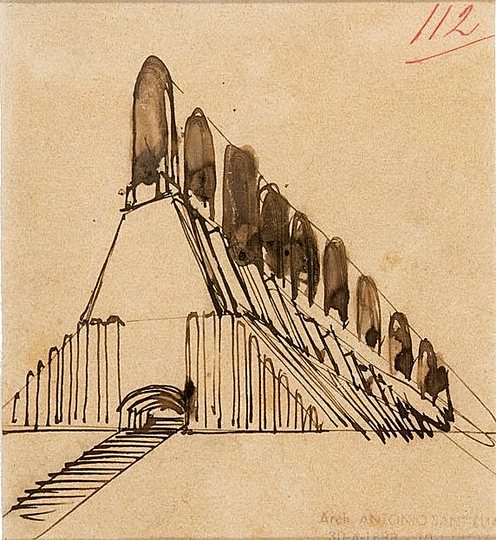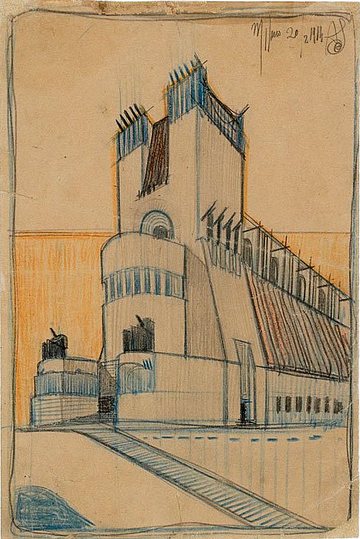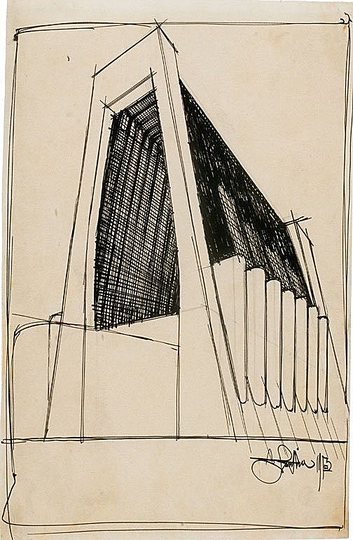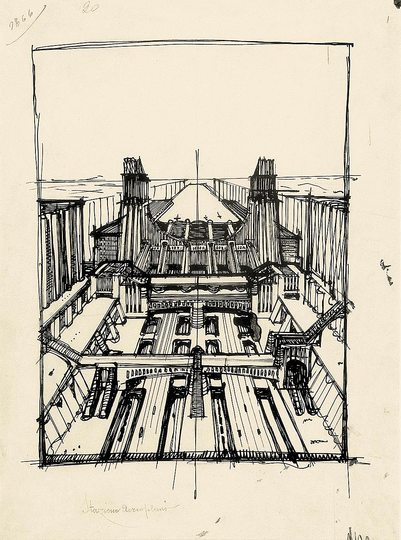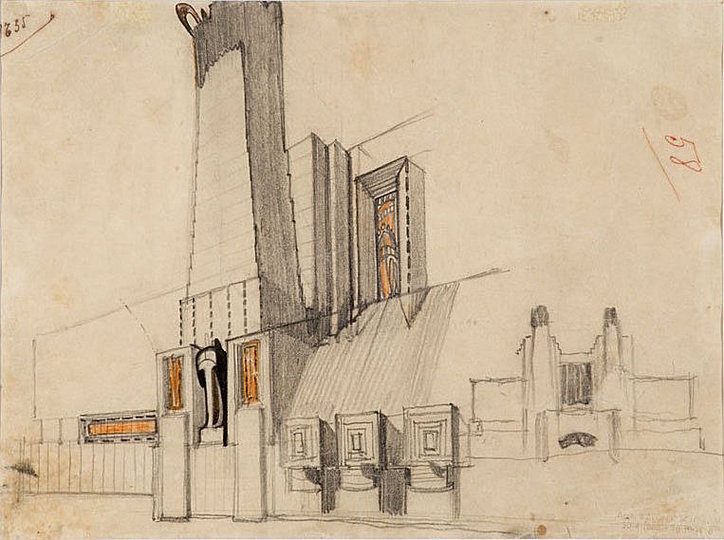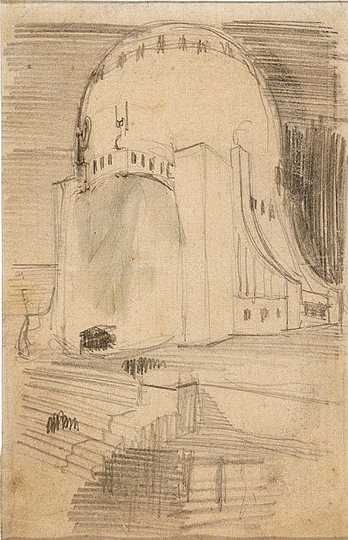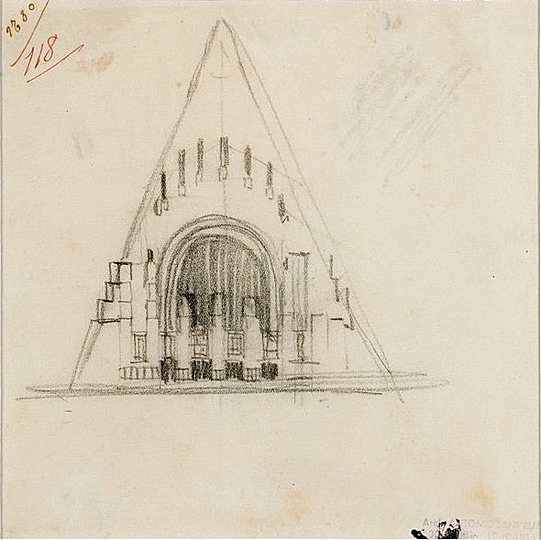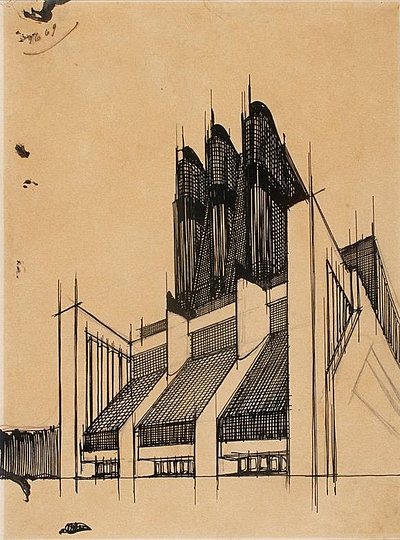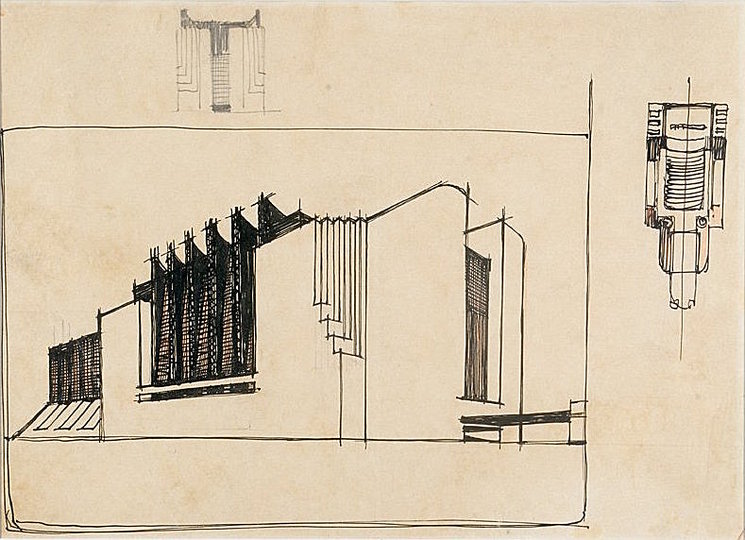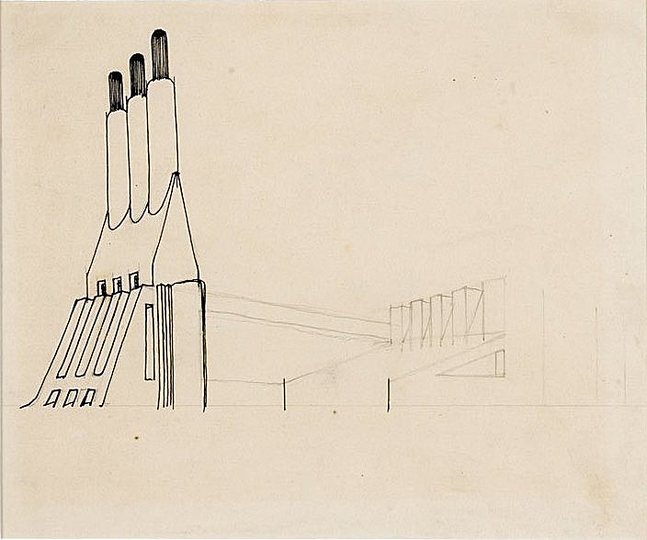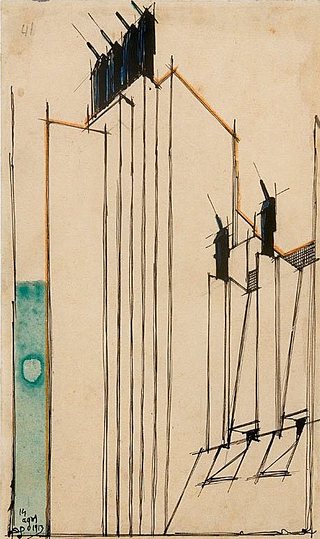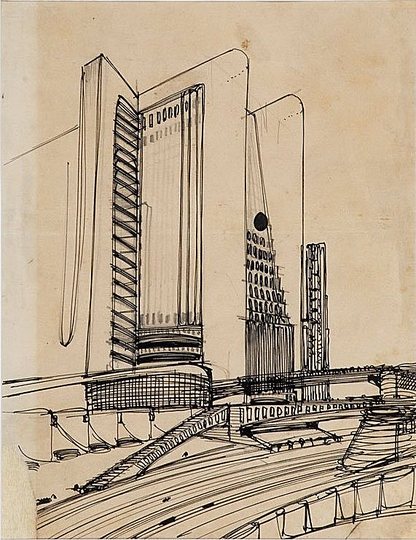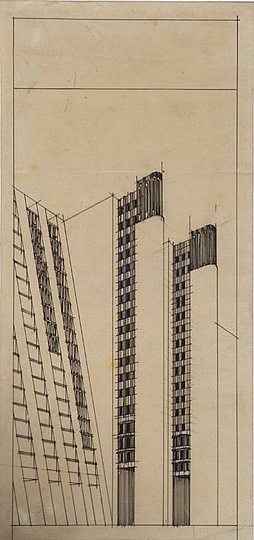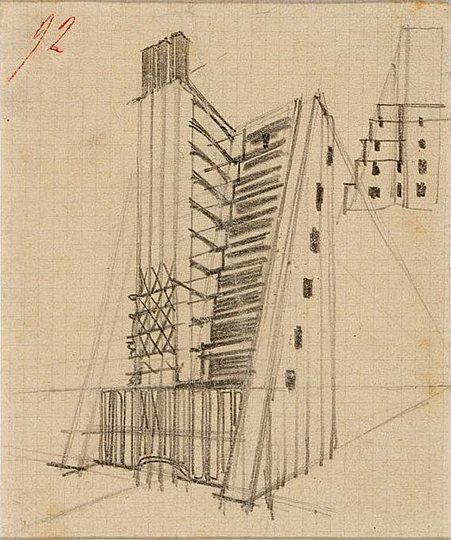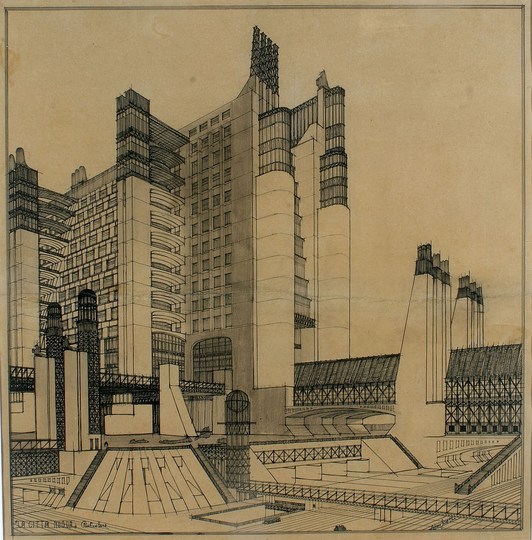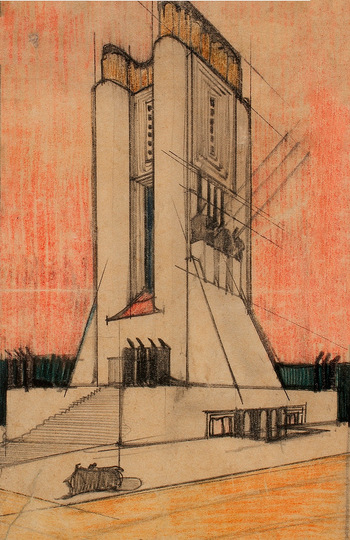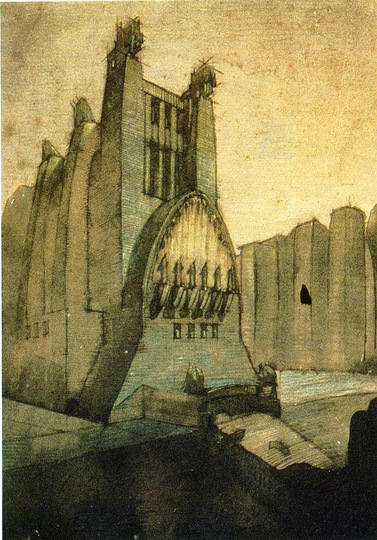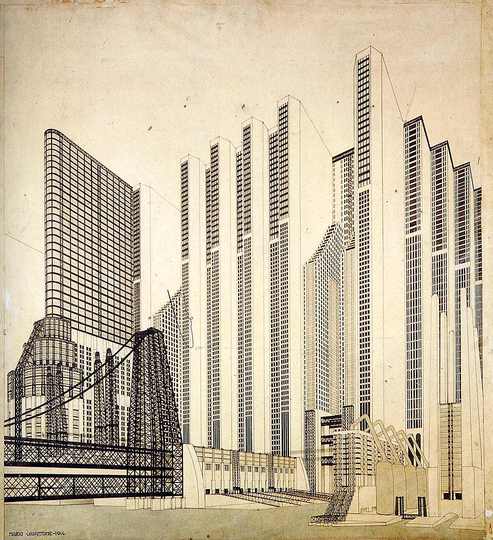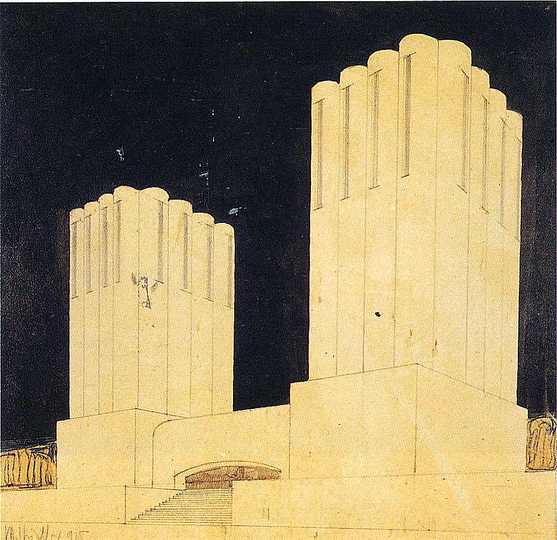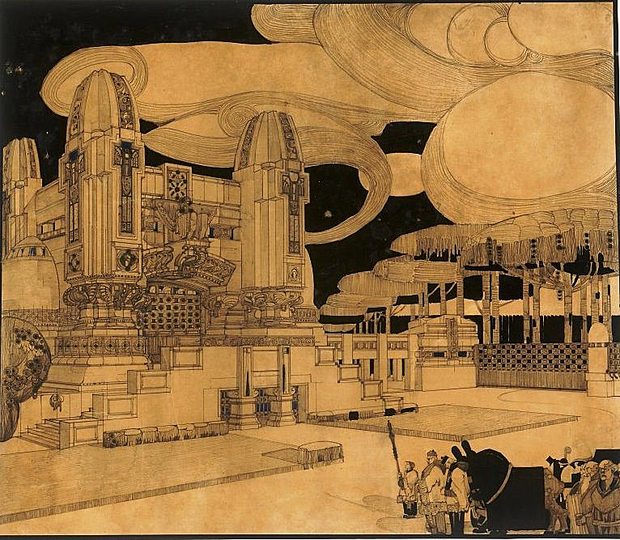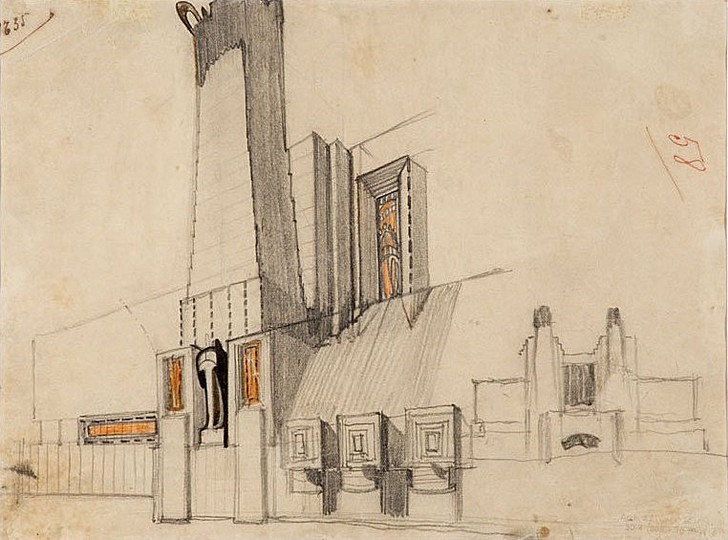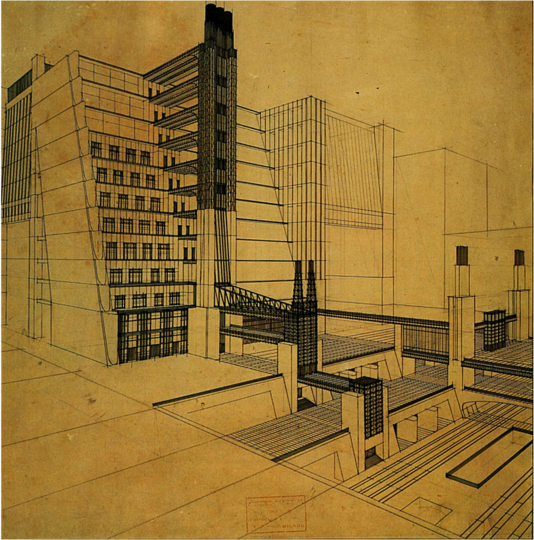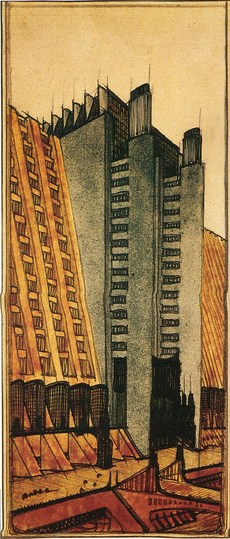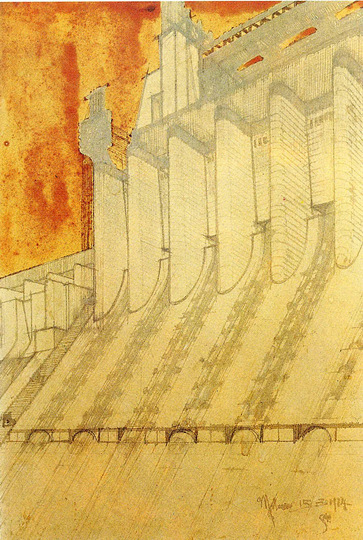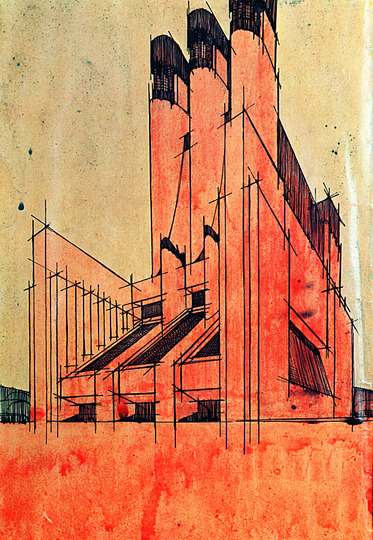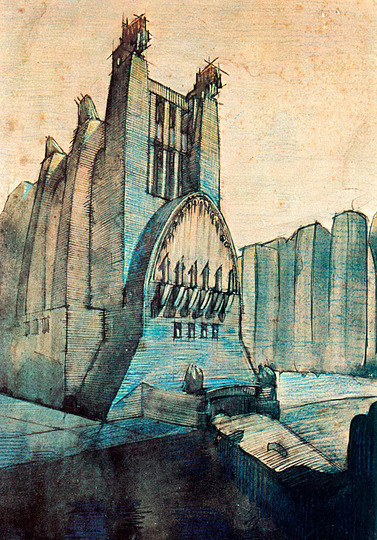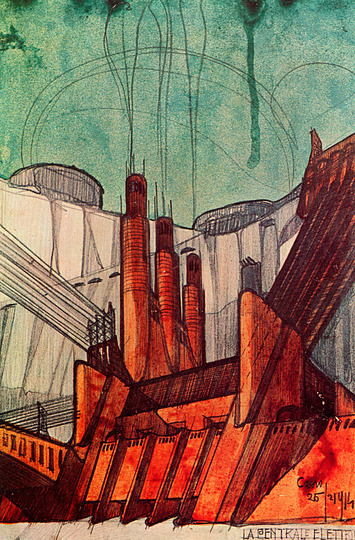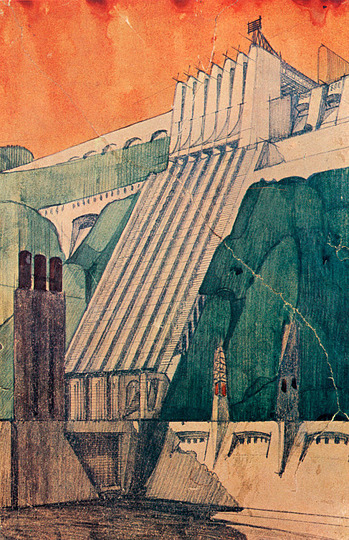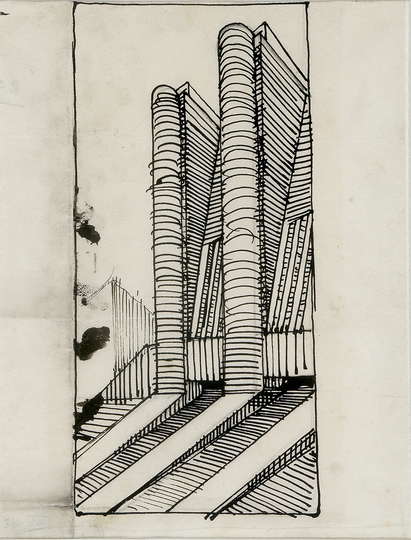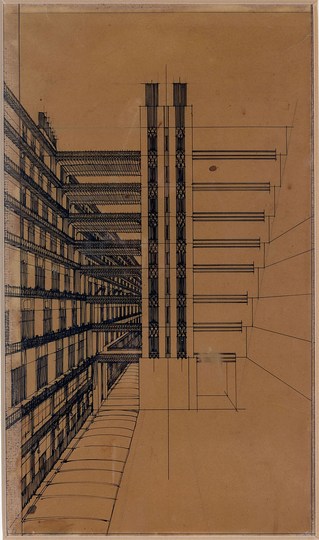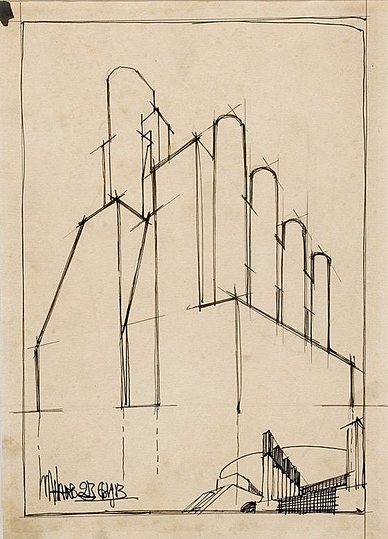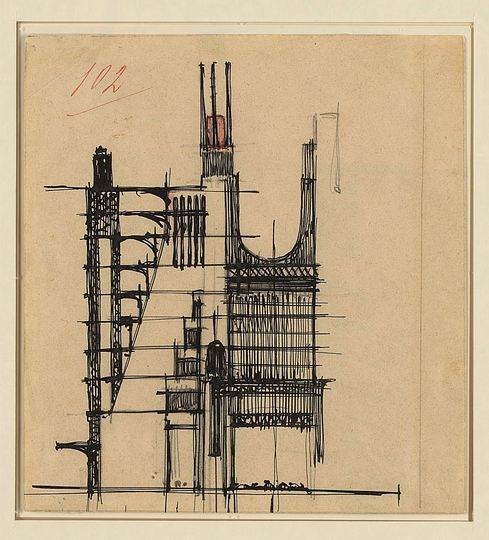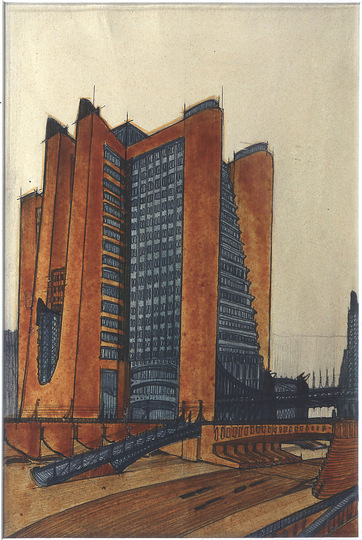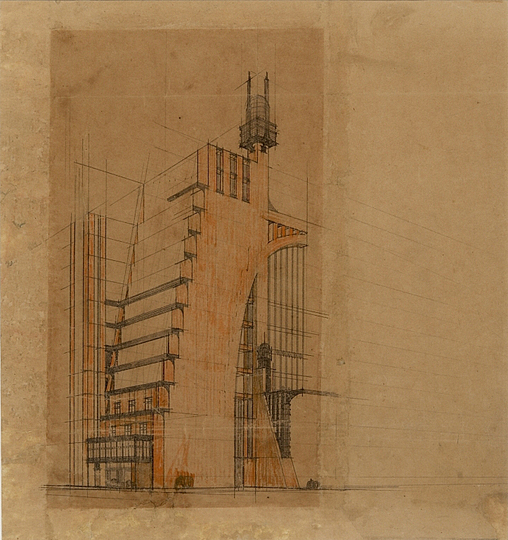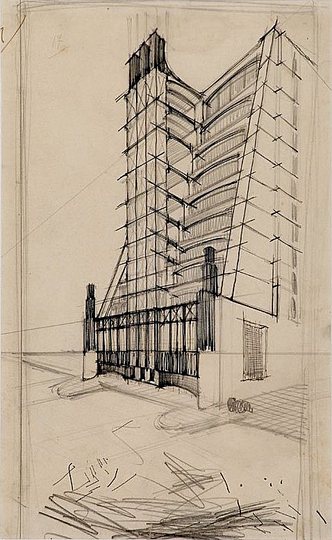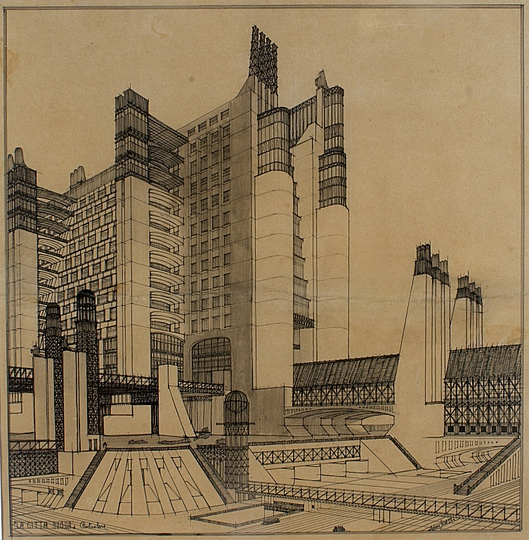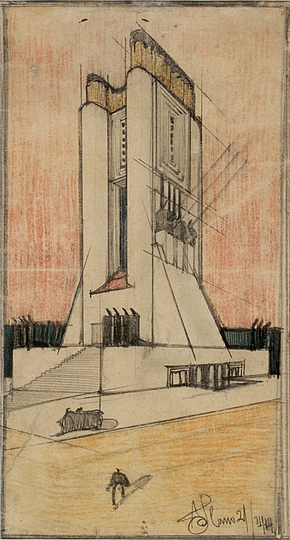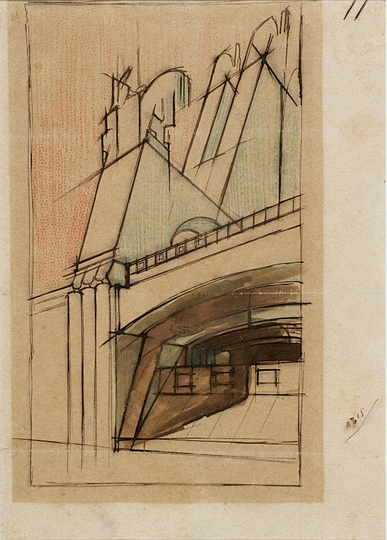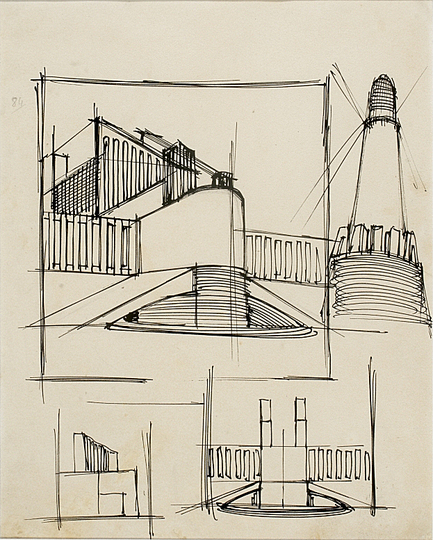Antonio Sant´Elia: The house of concrete, glass and steel
"I COMBAT AND DESPISE: All the pseudo-architecture of the avant-garde, Austrian, Hungarian, German and American; All classical architecture, solemn, hieratic, scenographic, decorative, monumental, pretty and pleasing; The embalming, reconstruction and reproduction of ancient monuments and palaces; Perpendicular and horizontal lines, cubical and pyramidical forms that are static, solemn, aggressive and absolutely excluded from our utterly new sensibility; The use of massive, voluminous, durable, antiquated and costly materials. AND PROCLAIM: That Futurist architecture is the architecture of calculation, of audacious temerity and of simplicity; the architecture of reinforced concrete, of steel, glass, cardboard, textile fiber, and of all those substitutes for wood, stone and brick that enable us to obtain maximum elasticity and lightness; That Futurist architecture is not because of this an arid combination of practicality and usefulness, but remains art, i.e. synthesis and expression; That oblique and elliptic lines are dynamic, and by their very nature possess an emotive power a thousand times stronger than perpendiculars and horizontals, and that no integral, dynamic architecture can exist that does not include these; That decoration as an element superimposed on architecture is absurd, and that the decorative value of Futurist architecture depends solely on the use and original arrangement of raw or bare or violently colored materials; That, just as the ancients drew inspiration for their art from the elements of nature, we—who are materially and spiritually artificial—must find that inspiration in the elements of the utterly new mechanical world we have created, and of which architecture must be the most beautiful expression, the most complete synthesis, the most efficacious integration; That architecture as the art of arranging forms according to pre-established criteria is finished; That by the term architecture is meant the endeavor to harmonize the environment with Man with freedom and great audacity, that is to transform the world of things into a direct projection of the world of the spirit; From an architecture conceived in this way no formal or linear habit can grow, since the fundamental characteristics of Futurist architecture will be its impermanence and transience. Things will endure less than us. Every generation must build its own city. This constant renewal of the architectonic environment will contribute to the victory of Futurism which has already been affirmed by words-in-freedom, plastic dynamism, music without quadrature and the art of noises, and for which we fight without respite against traditionalist cowardice."
Manifesto of Futurist Architecture
Antonio Sant’Elia, 1888-1916
Inspirations.
Fashion, Food, Transport
FUTURE CITY premiered at Vienna Art Week 2018 on November 20, 2018, at MAK Museum of Applied Arts in...
Architecture
Designed and restored by Ted Wells. Happy with my historic house: 1960, originally designed by Moshe...
Architecture
Designed by Ted Wells. Architecture. Corten steel and glass.
Architecture
Designed by Ted Wells. Great ocean and canyon views. Glass, stone, and steel.
Carlo Scarpa
jardin des sculptures. C Scarpa
The loft bar
Concept project of loft bar.
Mechanical Suprematist
Experience interesting architectural compositions being created as you look around. This generator w...
Immersive sketch
Travel through an animated architectural sketch (move mouse to look around): http://mariogagliardi.c...
penccil: This was 2017
The penccil year in review is a project selection for 2017, this year curated by Mario Gagliardi. Se...
serpentine 2017
exhibition, schauspiel köln, cologne. steelobjects, ceramic reliefs.
BS1
temporary accessible sculpture.
BKM/Barozzi/Veiga
The extension of the Villa Planta, which will accommodate the Bündner Kunstmuseum, is an exercise o...
Fallingwater
Modernist Architecture by Frank Lloyd Wright
Green Architecture…. Is it blessing or curse!!
GREEN ARCHITECTURE….IT IS GOOD FOR THE NATURAL WORLD OR MAYBE IT WILL BE A MESS OF THE TREES AND P...
Library
A library in the center of Moscow, study project.
Vico Magistretti
Vico Magistretti (1920 - 2006) studied in Lausanne and Milano. He was one of the main protagonists o...
Franz Kline
Around 1950, Franz Kline radically simplified painting: “Instead of making a sign you can read, yo...
Lattice
Architectural structures. Mario Gagliardi 2006
Gaetano Pesce: Abstraction is boring
"Abstraction is boring and limited as a mode of expression. Reducing and reducing designs means that...
Chromatic seating
3 colorful seats by 3 Italian designers: Giancarlo Zema graduated from the Faculty of Architecture o...
Kenzo Tange
Kenzo Tange was born September 4, 1913 in Osaka, Japan. After graduating from the University of Toky...
Organic Public
Contemporary cities are in need of public spaces which work better for their citizens. This proposal...
Design for Disaster
"A disaster zone where everything is lost offers the perfect opportunity for us to take a fresh look...
Shared Space
To develop better urban strategies and futures for communities in desert climates, Mario Gagliardi w...
Books of Memory: Gianpaolo Pagni
Gianpaolo Pagni creates unique, printed, painted or stamped books. His work focuses around memory an...
Memphis Posters
4 posters by the legendary Italian design collective Memphis Milano.
Food Architecture
Food dal cucchiaio al mondo: Works of artists and architects who deal with the global political, soc...
Sky Walk
The Dolní Morava tower Sky Walk by Zdenek Franek is a conceptual building, and it offers visitors ...
Joe Colombo: Total Furnishing Unit
The Total furnishing unit: Bathroom by Joe Colombo, Milano 1971.
Pillars
Consisting of connected bricks whose relative position can be altered by changing underlying paramet...
Microscopes of utopia
This are some of landscapes spaces of nowhere with spaces inside
Brazil Modernism
20th century architecture in Brazil, including work by Lina Bo Bardi, Lúcio Costa, Affonso Reidy, O...
Carlo Scarpa: Sketch and Work
There is hardly another architect of the 20th century in whose work the progression from sketch to c...
Peter Zumthor: Thinking Architecture
A selection of remarkable work by Swiss architect Peter Zumthor.
The Bauhaus Revolution
The Bauhaus was the most influential design school of the 20th century.
See more in the new magazin...
E=C=L=I=P=S=E
Cerith Wyn Evans is a Welsh sculptor and filmmaker. He worked as an assistant to Derek Jarman, at th...
In Orbit
"When I look at these complex layers of translucent lines and spheres, I am reminded of models of th...
Tom Ngo
"Common sense and conventional practice prohibits the evolution of architecture. Through reproducing...
Sislej Xhafa
Sislej Xhafa has furnished the waiting room of a police station in Gent like a grand palace. He pres...
Future Architecture
Future Architecture Platform is a European program which promotes talents in architecture. Future A...
Superstudio, Superproduction, Superconsumption
Superarchitecture is the architecture of superproduction, of superconsumption, of superinduction to ...
Heartbeat, Heartseat
Heartbeat consists of a massive heart glowing to the rhythm of a strong, deep and low frequency hear...
Swarm fabrication: Kokkugia / Roland Snooks
We have a fascination with the impact of new technologies on architecture and construction. We are f...
Spatial Clusters
"Refined nature consists of evolved technology such as robotics, artificial intelligence, cybernetic...
Une Cité Industrielle by Tony Garnier
Tony Garnier designed the plans of an ideal city during his stay at the Villa Médicis from 1899 to ...
L’ITALIA CI GUARDIA
On the occasion of the 70th anniversary of the birth of the Italian Republic, 40 masters of photogra...
The Glass House
"This house was Philip Johnson's autobiography—all of his interests were visible, and all of his a...
20th Century Italian Tables
A collection of 20th century Italian table designs.
Julius Shulman: Visual Drama
"Julius had an eye for visual drama. With modernist buildings, he loved capturing the strong lines s...
Robert Slezak
A trained locksmith from Bystrice pod Hostýnem, then part of the Austro-Hungarian Empire, Robert Sl...
Bird´s Nest
I am often struck by the nests that crows build using clothes hangers. Hangers are not only durable ...
BASILE ARTECO "Monoblocco" design Donata Paruccini
pen-holder design Donata Paruccini
BASILE ARTECO
BASILE ARTECO EDIZIONI logo
BASILE ARTECO "Falce/Scythe" design anonimo
Design Anonimo, Scythe in forged iron handmade in Italy in the occasion of the exhibition of the "FE...
BASILE ARTECO "Ferro/D" design Enzo Mari
DESIGN ENZO MARI: Forged iron and Murano Glass Vase, Limited Edition of 6, numbered and signed by th...
BASILE ARTECO "Ferro/A" design Enzo Mari
DESIGN ENZO MARI: Forged iron fruit-bowl Limited Edition of 4, numbered and signed by the Author Enz...
BASILE ARTECO "Ferro/B" design Enzo Mari
DESIGN ENZO MARI: Forged iron fruit-bowl, Limited Edition of 6 numberd and signed by the Author Enzo...
BASILE ARTECO "Ferro/C" design Enzo Mari
DESIGN ENZO MARI: Forged iron and Murano Glass Vase, limited Edition of 4 signed and numbered by the...
BASILE ARTECO "L´Utopia" design Enzo Mari
ENZO MARI: Original hand written script on paper for Vincenzo Basile
exhibition "Ferri Forgiati" Gal...
BASILE ARTECO "Monoblocco/L" design Donata Paruccini
DESIGN DONATA PARUCCINI: pen holder
BASILE ARTECO "Coquetier" design Paolo Ulian
DESIGN PAOLO ULIAN: egg-holder
Mimicry and Makeshift
Two future visions for urbanism and ownership:
Mimicry city - where everything wants to be owned. As...
Colliding Worlds
Architectural models of small planets appear in unexpected places. (C) Mario Gagliardi 2007
Jean-Jaques Lequeu
Jean-Jacques Lequeu (1757-1825) worked as a draughtsman at Rouen, and from 1779 in Paris at the Cad...
Jorge Zalszupin and L'Atelier
Jorge Zalszupin (b. 1922), a native of Warsaw, Poland, studied architecture at Bucharest's Ecole des...
Amor Vacui
Domink von Moos, born 1990, studied architecture at ETH Zurich.
Archispecture
Architectural studies. Mario Gagliardi 2007-2010.
Small Buildings
Photographer Eric Tabuchi, born 1959, lives and works in Paris.
Bring the outside in: The houses of Joseph Eichler
“Eichlers,” as they are referred to in California, are midcentury modern tract homes developed b...
Harrison and Abramovitz
Architects Wallace Harrison and Max Abramovitz, who worked independently in New York in a partnershi...
also:
Encore Melaka in Film
Film: Kodak Colourplus 200
Earth Works
Multi-collage research, between objects, land art and drawing.
Field of Notion
Field of Notion delves into the dichotomies of light and shadows, life and death, creating a series ...
HOGAR, DULCE HOGAR
Collage
Alpina
Chair "Alpina" designed by Mario Gagliardi for Mario and Casa.
Pianeti
Rug set "Pianeti", designed by Mario Gagliardi for Mario and Casa. Handcrafted in 100% New Zealand M...
Flow
Dining Table "Flow" designed by Mario Gagliardi for Mario and Casa.
Gran Turismo
Lounge chair Gran Turismo, Design Mario Gagliardi for Mario and Casa.
String Theory: Architecture of Connections
This speculative project starts with the idea that space is not defined by volume, but by connectio...
The painted house
These experimental structures have been created by combining design processes of architecture and gr...
Casa Sperimentale
One of the most visionary built experiments of 20th century architecture was created through the per...
colors
colors
SCARABOOK
SCARABOOK is the combination of Scarabottolo and the English word book (but perhaps we ought to say ...
My calendar
I start to make it in 2000, the year in which the future has passed, at the request of Adriano Mei G...
71 views of the magic mountain
In the days of the first lockdown I started making these drawings, remotely inspired by Hokusai´s "...
on paper books and e-books
these drawings were made thinking about what is happening to the books through various titles of cla...
Last and First Men
The first and last movie by iconic Icelandic composer Jóhann Jóhannsson (1969 - 2018). With his mu...
el cairel II
turistic housing complex buit in reinforced concret
No.5 Warehouse Museum of Fossil
A space in the headquarter of a stone manufacturer in China. With its monochromatic walls, oddly sla...
Pulp architecture
The need to stand out in a hyper-commercialized market results in remarkable examples of contemporar...
Dovecote-Granary
Tiago Do Vale took on the admirable task of restoring two maize granaries as examples for disappeari...
Core Agora
These shop pavillions in an area of a hotel complex in Greece, designed by Not a Number Architects, ...
Sonata
Sonata, a multi-housing project in Merida, Mexico, was designed by Mexican practice Arkham. Partly e...
K11 Musea
Westworld meets Surrealism in the interior design of K11 Musea, a new shopping mall in Hong Kong, a ...
Lotus Zen House
The Lotus Zen House hotel is located in Mount Jiuhua, an important Buddhist site in China. Hong Kong...
Laurel Hills Residence
A beautiful example of a contemporary Californian residence, designed by Assembledge architects. The...
House 33
House No 33 by Uemori Masaaki and Uemori Kokutou: A fantastic example on how contemporary architectu...
Architectural sculptures
Architectural sculptures by K. Kegelmann as part of "Future City" curated by Mario Gagliardi at the ...
The gilded castle
Besides castle Neuschwanstein in Bavaria, Peles is the most remarkable turn-of-the-century castle i...
The Heavy Palace
The Palace of the Parliament in Bucharest was built in the nineteen-eighties after a design by Anca ...
Reactive Space
Inspired by Plato´s allegory of the cave, this is an architectural study for spaces reacting to its...
Calatrava : Sculptures
Sculptures by architect Santiago Calatrava.
PIXelated Cube
experiment idea materialmatters architecture
CAMOUFLAGE ARCHITECTURE
My thesis gallery about camouflage and architecture
The Venice Pavillon
The Venice Pavillon interprets the history of Venice as a point of contact between West and East. Sh...
Collaborative City Planning
The result of the Zero Carbon project: a collaborative scale model of the prototype site, close to t...
Structures
Architectural studies, Mario Gagliardi 2002-2004.
Dreaming of Skyscrapers
Mario Gagliardi 2006.
Who made this chair????
mystery chair...metal work reminds me of Robert Slezák. Limited chair production by Dupre-Perrin in...
Alessandro Mendini 1931-2019
For Alchimia, design is a cyle: everything that will have to happen has already happened, and the im...
Terror Architecture -18th Century Prisons
In the late 1770s, there was a particular interest in the development of not only scientific and rhe...
Kunio Makaewa
Kunio Maekawa was a master of Japanese modernist architecture. He learned under Le Corbusier and was...
Good art inspires; Good design motivates.
— Otl Aicher
— Otl Aicher
- penccil is free.
- No trackers. No cookies.
Just creativity.
